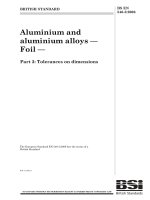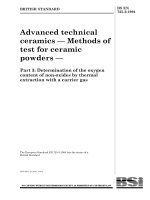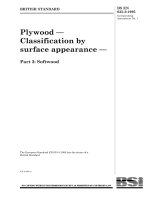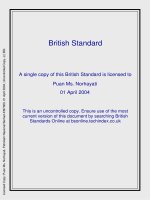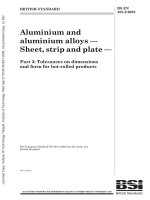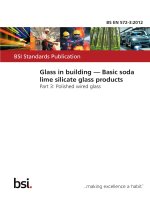Bsi bs en 61158 3 11 2008
Bạn đang xem bản rút gọn của tài liệu. Xem và tải ngay bản đầy đủ của tài liệu tại đây (553.77 KB, 40 trang )
BS EN 61158-3-11:2008
BSI British Standards
Industrial communication
networks — Fieldbus
specifications —
Part 3-11: Data-link layer service
definition — Type 11 elements
NO
NO COPYING
COPYING WITHOUT
WITHOUT BSI
BSI PERMISSION
PERMISSION EXCEPT
EXCEPT AS
AS PERMITTED
PERMITTED BY
BY COPYRIGHT
COPYRIGHT LAW
LAW
raising standards worldwide™™
BRITISH STANDARD
BS EN EN 61158-3-11:2008
National foreword
This British Standard is the UK implementation of EN 61158-3-11:2008. It is
identical to IEC 61158-3-11:2007. Together with all of the other sections of
BS EN 61158-3, it supersedes BS EN 61158-3:2004 which is withdrawn.
The UK participation in its preparation was entrusted to Technical Committee
AMT/7, Industrial communications: process measurement and control, including fieldbus.
A list of organizations represented on this committee can be obtained on
request to its secretary.
This publication does not purport to include all the necessary provisions of a
contract. Users are responsible for its correct application.
© BSI 2009
ISBN 978 0 580 61566 5
ICS 25.040.40; 35.100.20; 35.240.50
Compliance with a British Standard cannot confer immunity from
legal obligations.
This Draft for Development was published under the authority of the
Standards Policy and Strategy Committee on 31 January 2009
Amendments issued since publication
Amd. No.
Date
Text affected
BS EN 61158-3-11:2008
EUROPEAN STANDARD
EN 61158-3-11
NORME EUROPÉENNE
February 2008
EUROPÄISCHE NORM
ICS 35.100.20; 25.040.40
Partially supersedes EN 61158-3:2004
English version
Industrial communication networks Fieldbus specifications Part 3-11: Data-link layer service definition Type 11 elements
(IEC 61158-3-11:2007)
Réseaux de communication industriels Spécifications des bus de terrain Partie 3-11: Définition des services
des couches de liaison de données Eléments de type 11
(CEI 61158-3-11:2007)
Industrielle Kommunikationsnetze Feldbusse Teil 3-11: Dienstfestlegungen des
Data Link Layer (Sicherungsschicht) Typ 11-Elemente
(IEC 61158-3-11:2007)
This European Standard was approved by CENELEC on 2008-02-01. CENELEC members are bound to comply
with the CEN/CENELEC Internal Regulations which stipulate the conditions for giving this European Standard
the status of a national standard without any alteration.
Up-to-date lists and bibliographical references concerning such national standards may be obtained on
application to the Central Secretariat or to any CENELEC member.
This European Standard exists in three official versions (English, French, German). A version in any other
language made by translation under the responsibility of a CENELEC member into its own language and notified
to the Central Secretariat has the same status as the official versions.
CENELEC members are the national electrotechnical committees of Austria, Belgium, Bulgaria, Cyprus, the
Czech Republic, Denmark, Estonia, Finland, France, Germany, Greece, Hungary, Iceland, Ireland, Italy, Latvia,
Lithuania, Luxembourg, Malta, the Netherlands, Norway, Poland, Portugal, Romania, Slovakia, Slovenia, Spain,
Sweden, Switzerland and the United Kingdom.
CENELEC
European Committee for Electrotechnical Standardization
Comité Européen de Normalisation Electrotechnique
Europäisches Komitee für Elektrotechnische Normung
Central Secretariat: rue de Stassart 35, B - 1050 Brussels
© 2008 CENELEC -
All rights of exploitation in any form and by any means reserved worldwide for CENELEC members.
Ref. No. EN 61158-3-11:2008 E
BS EN 61158-3-11:2008
EN 61158-3-11:2008
-2-
Foreword
The text of document 65C/473/FDIS, future edition 1 of IEC 61158-3-11, prepared by SC 65C, Industrial
networks, of IEC TC 65, Industrial-process measurement, control and automation, was submitted to the
IEC-CENELEC parallel vote and was approved by CENELEC as EN 61158-3-11 on 2008-02-01.
This and the other parts of the EN 61158-3 series supersede EN 61158-3:2004.
With respect to EN 61158-3:2004 the following changes were made:
– deletion of Type 6 fieldbus, and the placeholder for a Type 5 fieldbus data-link layer, for lack of market
relevance;
– addition of new fieldbus types;
– partition into multiple parts numbered 3-1, 3-2, …, 3-19.
The following dates were fixed:
– latest date by which the EN has to be implemented
at national level by publication of an identical
national standard or by endorsement
(dop)
2008-11-01
– latest date by which the national standards conflicting
with the EN have to be withdrawn
(dow)
2011-02-01
NOTE Use of some of the associated protocol types is restricted by their intellectual-property-right holders. In all cases, the
commitment to limited release of intellectual-property-rights made by the holders of those rights permits a particular data-link layer
protocol type to be used with physical layer and application layer protocols in type combinations as specified explicitly in the
EN 61784 series. Use of the various protocol types in other combinations may require permission from their respective
intellectual-property-right holders.
Annex ZA has been added by CENELEC.
__________
Endorsement notice
The text of the International Standard IEC 61158-3-11:2007 was approved by CENELEC as a European
Standard without any modification.
In the official version, for Bibliography, the following notes have to be added for the standards indicated:
IEC 61158-5-11
NOTE Harmonized as EN 61158-5-11:2008 (not modified).
IEC 61158-6-11
NOTE Harmonized as EN 61158-6-11:2008 (not modified).
IEC 61784-2
NOTE Harmonized as EN 61784-2:2008 (not modified).
__________
BS EN 61158-3-11:2008
-3-
EN 61158-3-11:2008
Annex ZA
(normative)
Normative references to international publications
with their corresponding European publications
The following referenced documents are indispensable for the application of this document. For dated
references, only the edition cited applies. For undated references, the latest edition of the referenced
document (including any amendments) applies.
NOTE When an international publication has been modified by common modifications, indicated by (mod), the relevant EN/HD
applies.
Publication
Year
Title
EN/HD
IEC 61158-4-11
-
1)
Industrial communication networks - Fieldbus EN 61158-4-11
specifications Part 4-11: Data-link layer protocol
specification - Type 11 elements
ISO/IEC 7498-1
-
1)
ISO/IEC 7498-3
-
ISO/IEC 8802-3
Year
2008
2)
Information technology - Open Systems
Interconnection - Basic Reference Model:
The Basic Model
EN ISO/IEC 7498-1 1995
2)
1)
Information technology - Open Systems
Interconnection - Basic Reference Model:
Naming and addressing
-
-
-
1)
Information technology - Telecommunications and information exchange between systems Local and metropolitan area networks Specific requirements Part 3: Carrier sense multiple access with
collision detection (CSMA/CD) access
method and physical layer specifications
-
ISO/IEC 10731
-
1)
Information technology - Open Systems
Interconnection - Basic reference model Conventions for the definition of OSI services
-
ISO/TR 13283
-
1)
Industrial automation - Time-critical
communications architectures - User
requirements and network management for
time-critical communications systems
-
1)
Undated reference.
2)
Valid edition at date of issue.
-
BS EN 61158-3-11:2008
–2–
61158-3-11 © IEC:2007(E)
CONTENTS
INTRODUCTION.....................................................................................................................6
1
Scope ...............................................................................................................................7
2
1.1 Overview .................................................................................................................7
1.2 Specifications ..........................................................................................................7
1.3 Conformance...........................................................................................................7
Normative references .......................................................................................................8
3
Terms, definitions, symbols, abbreviations and conventions ............................................. 8
4
3.1 Reference model terms and definitions ....................................................................8
3.2 Service convention terms and definitions............................................................... 10
3.3 Data-link service terms and definitions .................................................................. 10
3.4 Symbols and abbreviations.................................................................................... 13
3.5 Common conventions ............................................................................................ 14
Data-link service and concept......................................................................................... 15
5
4.1 Overview ............................................................................................................... 15
4.2 General description of services ............................................................................. 16
4.3 TCC data service................................................................................................... 20
4.4 Detail description of the sporadic message data service ........................................ 24
DL- management services .............................................................................................. 26
5.1 General ................................................................................................................. 26
5.2 Facilities of the DL-management service ............................................................... 26
5.3 Service of the DL-management ............................................................................. 26
5.4 Overview of interactions ........................................................................................ 27
5.5 Detail specification of service and interactions ...................................................... 29
Bibliography.......................................................................................................................... 35
Figure 1 – Relationships of DLSAPs, DLSAP-addresses and group DL-addresses ................ 11
Figure 2 – Overall flow of data frames during one minimum cycle period (high-speed
transmission period) ................................................................................................ 17
Figure 3 – Overall flow of cyclic data frames over one maximum cycle period (lowspeed transmission period) ..................................................................................... 18
Figure 4 – Sequence diagram of TCC data service ............................................................... 19
Figure 5 – Sequence diagram of sporadic message service .................................................. 19
Figure 6 – Relationship of DLSAP, DLCEP and DLCEP-address ........................................... 20
Figure 7 – Sequence diagram of Reset, Set-value, Get-value, Set-publisherconfiguration, Get-publisher-configuration, Activate-TCC-data and DeactivateTCC-data service primitives .................................................................................... 28
Figure 8 – Sequence diagram of sporadic message service .................................................. 28
Table 1 – Primitives and parameters used on the time-critical cyclic data service ................. 21
Table 2 – Data request primitives and the parameters .......................................................... 21
Table 3 – Put buffer primitives and parameters ..................................................................... 22
Table 4 – Get buffer primitives and parameters..................................................................... 23
Table 5 – Notify buffer received primitives and parameters ................................................... 23
BS EN 61158-3-11:2008
61158-3-11 © IEC:2007(E)
–3–
Table 6 – Primitives and parameters used on sporadic message data service....................... 24
Table 7 – Submit sporadic message primitives and parameters ............................................ 25
Table 8 – Summary of DL-management primitives and parameters ....................................... 28
Table 9 – DLM-Reset primitives and parameters ................................................................... 29
Table 10 – DLM-Set-value primitives and parameters ........................................................... 29
Table 11 – DLM-Get-value primitives and parameters ........................................................... 30
Table 12 – Event primitives and parameters ......................................................................... 31
Table 13 – Set-publisher-configuration primitives and parameters ........................................ 31
Table 14 – DLM-Get-publisher-configuration primitives and parameters ................................ 32
Table 15 – DLM-Activate-TCC primitives and the parameters ............................................... 33
Table 16 – DLM-Deactivate-TCC primitives and the parameters ........................................... 34
BS EN 61158-3-11:2008
–6–
61158-3-11 © IEC:2007(E)
INTRODUCTION
This part of IEC 61158 is one of a series produced to facilitate the interconnection of
automation system components. It is related to other standards in the set as defined by the
“three-layer” fieldbus reference model described in IEC/TR 61158-1.
Throughout the set of fieldbus standards, the term “service” refers to the abstract capability
provided by one layer of the OSI Basic Reference Model to the layer immediately above. Thus,
the data-link layer service defined in this standard is a conceptual architectural service,
independent of administrative and implementation divisions.
BS EN 61158-3-11:2008
61158-3-11 © IEC:2007(E)
–7–
INDUSTRIAL COMMUNICATION NETWORKS –
FIELDBUS SPECIFICATIONS –
Part 3-11: Data-link layer service definition – Type 11 elements
1 Scope
1.1 Overview
This part of IEC 61158 provides common elements for basic time-critical messaging
communications between devices in an automation environment. The term “time-critical” is
used to represent the presence of a time-window, within which one or more specified actions
are required to be completed with some defined level of certainty. Failure to complete
specified actions within the time window risks failure of the applications requesting the actions,
with attendant risk to equipment, plant and possibly human life.
This standard defines in an abstract way the externally visible service provided by the
Type 11 fieldbus data-link layer in terms of
a) the primitive actions and events of the service;
b) the parameters associated with each primitive action and event, and the form which they
take; and
c) the interrelationship between these actions and events, and their valid sequences.
The purpose of this standard is to define the services provided to
•
the Type 11 fieldbus application layer at the boundary between the application and datalink layers of the fieldbus reference model, and
•
systems management at the boundary between the data-link layer and systems
management of the fieldbus reference model.
1.2 Specifications
The principal objective of this standard is to specify the characteristics of conceptual data-link
layer services suitable for time-critical communications, and thus supplement the OSI Basic
Reference Model in guiding the development of data-link protocols for time-critical
communications. A secondary objective is to provide migration paths from previously-existing
industrial communications protocols.
This specification may be used as the basis for formal DL-Programming-Interfaces.
Nevertheless, it is not a formal programming interface, and any such interface will need to
address implementation issues not covered by this specification, including
a) the sizes and octet ordering of various multi-octet service parameters, and
b) the correlation of paired request and confirm, or indication and response, primitives.
1.3 Conformance
This standard do not specify individual implementations or products, nor do they constrain the
implementations of data-link entities within industrial automation systems.
There is no conformance of equipment to this data-link layer service definition standard.
Instead, conformance is achieved through implementation of the corresponding data-link
protocol that fulfills the Type 11 data-link layer services defined in this standard.
BS EN 61158-3-11:2008
–8–
61158-3-11 © IEC:2007(E)
2 Normative references
The following referenced documents are indispensable for the application of this document.
For dated references, only the edition cited applies. For undated references, the latest edition
of the referenced document (including any amendments) applies.
IEC 61158-4-11, Industrial communication networks – Fieldbus specifications – Part 4-11:
Data-link layer protocol specification – Type 11 elements
ISO/IEC 7498-1, Information technology – Open Systems Interconnection – Basic Reference
Model: The Basic Model
ISO/IEC 7498-3, Information technology – Open Systems Interconnection – Basic Reference
Model: Naming and addressing
ISO/IEC 8802-3, Information technology – Telecommunications and information exchange
between systems – Local and metropolitan area networks – Specific requirements – Part 3:
Carrier sense multiple access with collision detection (CSMA/CD) access method and
physical layer specifications
IISO/IEC 10731, Information technology – Open Systems Interconnection – Basic Reference
Model – Conventions for the definition of OSI services
ISO/TR 13283, Industrial automation – Time-critical communications architectures – User
requirements and network management for time-critical communications systems
3 Terms, definitions, symbols, abbreviations and conventions
For the purposes of this document, the following terms, definitions, symbols, abbreviations
and conventions apply.
3.1 Reference model terms and definitions
This standard is based in part on the concepts developed in ISO/IEC 7498-1 and
ISO/IEC 7498-3, and makes use of the following terms defined therein.
3.1.1 DL-address
[7498-3]
3.1.2 DL-address-mapping
[7498-1]
3.1.3 called-DL-address
[7498-3]
3.1.4 calling-DL-address
[7498-3]
3.1.5 centralized multi-end-point-connection
[7498-1]
3.1.6 DL-connection
[7498-1]
3.1.7 DL-connection-end-point
[7498-1]
3.1.8 DL-connection-end-point-identifier
[7498-1]
3.1.9 DL-connection-mode transmission
[7498-1]
3.1.10 DL-connectionless-mode transmission
[7498-1]
3.1.11 correspondent (N)-entities
correspondent DL-entities (N=2)
correspondent Ph-entities (N=1)
[7498-1]
BS EN 61158-3-11:2008
61158-3-11 © IEC:2007(E)
–9–
3.1.12 DL-duplex-transmission
[7498-1]
3.1.13 (N)-entity
DL-entity (N=2)
Ph-entity (N=1)
[7498-1]
3.1.14 DL-facility
[7498-1]
3.1.15 flow control
[7498-1]
3.1.16 (N)-layer
DL-layer (N=2)
Ph-layer (N=1)
[7498-1]
3.1.17 layer-management
[7498-1]
3.1.18 DL-local-view
[7498-3]
3.1.19 DL-name
[7498-3]
3.1.20 naming-(addressing)-domain
[7498-3]
3.1.21 peer-entities
[7498-1]
3.1.22 primitive name
[7498-3]
3.1.23 DL-protocol
[7498-1]
3.1.24 DL-protocol-connection-identifier
[7498-1]
3.1.25 DL-protocol-data-unit
[7498-1]
3.1.26 DL-relay
[7498-1]
3.1.27 reset
[7498-1]
3.1.28 responding-DL-address
[7498-3]
3.1.29 routing
[7498-1]
3.1.30 segmenting
[7498-1]
3.1.31 (N)-service
DL-service (N=2)
Ph-service (N=1)
[7498-1]
3.1.32 (N)-service-access-point
DL-service-access-point (N=2)
Ph-service-access-point (N=1)
[7498-1]
3.1.33 DL-service-access-point-address
[7498-3]
3.1.34 DL-service-connection-identifier
[7498-1]
3.1.35 DL-service-data-unit
[7498-1]
3.1.36 DL-simplex-transmission
[7498-1]
3.1.37 DL-subsystem
[7498-1]
3.1.38 systems-management
[7498-1]
3.1.39 DLS-user-data
[7498-1]
BS EN 61158-3-11:2008
– 10 –
61158-3-11 © IEC:2007(E)
3.2 Service convention terms and definitions
This standard also makes use of the following terms defined in ISO/IEC 10731 as they apply
to the data-link layer:
3.2.1 acceptor
3.2.2 asymmetrical service
3.2.3 confirm (primitive);
requestor.deliver (primitive)
3.2.4 deliver (primitive)
3.2.5 DL-confirmed-facility
3.2.6 DL-facility
3.2.7 DL-local-view
3.2.8 DL-mandatory-facility
3.2.9 DL-non-confirmed-facility
3.2.10 DL-provider-initiated-facility
3.2.11 DL-provider-optional-facility
3.2.12 DL-service-primitive;
primitive
3.2.13 DL-service-provider
3.2.14 DL-service-user
3.2.15 DLS-user-optional-facility
3.2.16 indication (primitive);
acceptor.deliver (primitive)
3.2.17 multi-peer
3.2.18 request (primitive);
requestor.submit (primitive)
3.2.19 requestor
3.2.20 response (primitive);
acceptor.submit (primitive)
3.2.21 submit (primitive)
3.2.22 symmetrical service
3.3 Data-link service terms and definitions
3.3.1
common memory
virtual common memory over the Type 11 fieldbus, which is shared by the nodes participating
in the Type 11 fielbus and is primarily used for the real-time communications by the TCC data
service
3.3.2
DL-segment, link, local link
single DL-subnetwork in which any of the connected DLEs may communicate directly, without
any intervening DL-relaying, whenever all of those DLEs that are participating in an instance
of communication are simultaneously attentive to the DL-subnetwork during the period(s) of
attempted communication
BS EN 61158-3-11:2008
61158-3-11 © IEC:2007(E)
– 11 –
3.3.3
DLCEP-address
DL-address which designates either
a) one peer DL-connection-end-point, or
b) one multi-peer publisher DL-connection-end-point and implicitly the corresponding set of
subscriber DL-connection-end-points where each DL-connection-end-point exists within a
distinct DLSAP and is associated with a corresponding distinct DLSAP-address
3.3.4
DLSAP
distinctive point at which DL-services are provided by a single DL-entity to a single higherlayer entity
NOTE This definition, derived from ISO/IEC 7498-1, is repeated here to facilitate understanding of the critical
distinction between DLSAPs and their DL-addresses.
DLS-user-entity
DLS-user-entity
DLS-users
DLSAP
DLSAP
DLSAPaddress
DLSAPaddresses
DL-layer
DLSAP
group DLaddress
DLSAPaddress
DL-entity
PhSA P
PhSA P
Ph-layer
NOTE 1
DLSAPs and PhSAPs are depicted as ovals spanning the boundary between two adjacent layers.
NOTE 2
DL-addresses are depicted as designating small gaps (points of access) in the DLL portion of a DLSAP.
NOTE 3 A single DL-entity may have multiple DLSAP-addresses and group DL-addresses associated with a
single DLSAP.
Figure 1 – Relationships of DLSAPs, DLSAP-addresses and group DL-addresses
3.3.5
DL(SAP)-address
either an individual DLSAP-address, designating a single DLSAP of a single DLS-user, or a
group DL-address potentially designating multiple DLSAPs, each of a single DLS-user
NOTE This terminology is chosen because ISO/IEC 7498-3 does not permit the use of the term DLSAP-address to
designate more than a single DLSAP at a single DLS-user.
3.3.6
(individual) DLSAP-address
DL-address that designates only one DLSAP within the extended link
BS EN 61158-3-11:2008
– 12 –
NOTE
61158-3-11 © IEC:2007(E)
A single DL-entity may have multiple DLSAP-addresses associated with a single DLSAP.
3.3.7
extended link
DL-subnetwork, consisting of the maximal set of links interconnected by DL-relays, sharing a
single DL-name (DL-address) space, in which any of the connected DL-entities may
communicate, one with another, either directly or with the assistance of one or more of those
intervening DL-relay entities
NOTE
An extended link may be composed of just a single link.
3.3.8
frame
denigrated synonym for DLPDU
3.3.9
group DL-address
DL-address that potentially designates more than one DLSAP within the extended link. A
single DL-entity may have multiple group DL-addresses associated with a single DLSAP. A
single DL-entity also may have a single group DL-address associated with more than one
DLSAP
3.3.10
high-speed cyclic data
RTE data conveyed by means of the high-speed cyclic data transmission
3.3.11
high-speed cyclic data transmission
one of three levels of the TCC data service with the highest priority level
3.3.12
low-speed cyclic data
RTE data conveyed by means of the low-speed cyclic data transmission
3.3.13
low-speed cyclic data transmission
one of three levels of the TCC data service with the lowest priority level
3.3.14
medium-speed cyclic data
RTE data conveyed by means of the medium-speed cyclic data transmission
3.3.15
medium-speed cyclic data transmission
one of three levels of the TCC data service with the second priority level
3.3.16
multipoint connection
connection from one node to many nodes. Multipoint connection allows data transfer from a
single publisher to many subscriber nodes.
3.3.17
multi-peer DLC
centralized multi-end-point DL-connection offering DL-duplex-transmission between a single
distinguished DLS-user known as the publisher or publishing DLS-user, and a set of peer but
undistinguished DLS-users known collectively as the subscribers or subscribing DLS-users,
where the publishing DLS-user can send to the subscribing DLS-users as a group (but not
BS EN 61158-3-11:2008
61158-3-11 © IEC:2007(E)
– 13 –
individually), and the subscribing DLS-users can send to the publishing DLS-user (but not to
each other).
3.3.18
node
single DL-entity as it appears on one local link
3.3.19
node-id
two-octet primary identifier for the DLE on the local link, whose values are constrained
NOTE A permissible value is from 1 to 255. A value 0 is specifically used for the SYN node, which emits the SYN
frame.
3.3.20
receiving DLS-user
DL-service user that acts as a recipient of DLS-user-data
NOTE
A DL-service user can be concurrently both a sending and receiving DLS-user.
3.3.21
sending DLS-user
DL-service user that acts as a source of DLS-user-data
3.3.22
SYN node
node transmitting the SYN frame
3.3.23
sporadic message data service
aperiodic message transfer which sporadically occurs upon DLS-user requesting one or more
message to transfer, and regular ISO/IEC 8802-3 Ethernet message frame is transferred by
means of this message transfer
3.3.24
TCC data service
cyclic data transfer with three levels of the data transmission at the same time, of which each
data transmission level is according to the data priority and the data transmission period for
real-time delivery, and of which the data transmission period and the total data volume for
each level can be specified in designing phase and on application needs
3.4 Symbols and abbreviations
3.4.1 CM
Common memory
3.4.2 DL-
Data-link layer (as a prefix)
3.4.3 DLC
DL-connection
3.4.4 DLCEP
DL-connection-end-point
3.4.5 DLE
DL-entity (the local active instance of the data-link layer)
3.4.6 DLL
DL-layer
3.4.7 DLPCI
DL-protocol-control-information
3.4.8 DLPDU
DL-protocol-data-unit
3.4.9 DLM
DL-management
BS EN 61158-3-11:2008
– 14 –
61158-3-11 © IEC:2007(E)
3.4.10 DLME
DL-management entity (the local active instance of
DL-management)
3.4.11 DLMS
DL-management service
3.4.12 DLS
DL-service
3.4.13 DLSAP
DL-service-access-point
3.4.14 DLSDU
DL-service-data-unit
3.4.15 FIFO
First-in first-out (queuing method)
3.4.16 GCM
Global common memory
3.4.17 OSI
Open systems interconnection
3.4.18 Ph-
Physical layer (as a prefix)
3.4.19 PhE
Ph-entity (the local active instance of the physical layer)
3.4.20 PhL
Ph-layer
3.4.21 QoS
Quality of service
3.4.22 RTE
Real Time Ethernet
3.4.23 TCC
Time-critical cyclic
3.5 Common conventions
This standard uses the descriptive conventions given in ISO/IEC 10731.
The service model, service primitives, and time-sequence diagrams used are entirely abstract
descriptions; they do not represent a specification for implementation.
Service primitives, used to represent service user/service provider interactions (see ISO/IEC
10731), convey parameters that indicate information available in the user/provider interaction.
This standard uses a tabular format to describe the component parameters of the DLS
primitives. The parameters that apply to each group of DLS primitives are set out in tables
throughout the remainder of this standard. Each table consists of up to six columns,
containing the name of the service parameter, and a column each for those primitives and
parameter-transfer directions used by the DLS:
a) the request primitive’s input parameters;
b) the request primitive’s output parameters;
c) the indication primitive’s output parameters;
d) the response primitive’s input parameters; and
e) the confirm primitive’s output parameters.
NOTE The request, indication, response and confirm primitives are also known as requestor.submit,
acceptor.deliver, acceptor.submit, and requestor.deliver primitives, respectively (see ISO/IEC 10731).
One parameter (or part of it) is listed in each row of each table. Under the appropriate service
primitive columns, a code is used to specify the type of usage of the parameter on the
primitive and parameter direction specified in the column:
M
Parameter: mandatory for the primitive.
BS EN 61158-3-11:2008
61158-3-11 © IEC:2007(E)
– 15 –
U
Parameter: a user option which may or may not be provided depending on the
dynamic usage of the DLS-user. When not provided, a default value for the
parameter is assumed.
C
Parameter is conditional upon other parameters or upon the environment of
the DLS-user.
(Blank)
Parameter is never present.
Some entries are further qualified by items in brackets. These may be
a) a parameter-specific constraint
(=)
indicates that the parameter is semantically equivalent to the parameter in the
service primitive to its immediate left in the table.
b) an indication that some note applies to the entry
(n)
indicates that the following note n contains additional information pertaining to
the parameter and its use.
In any particular interface, not all parameters need be explicitly stated. Some may be
implicitly associated with the DLSAP at which the primitive is issued.
In the diagrams which illustrate these interfaces, dashed lines indicate cause-and-effect or
time-sequence relationships, and wavy lines indicate that events are roughly
contemporaneous.
4 Data-link service and concept
4.1 Overview
4.1.1 General
This standard specifies the Type 11 data-link services for a ISO/IEC 8802-3-based timecritical control network, which is one of the communication networks for Real-Time Ethernet
(RTE) defined in IEC 61784-2.
This standard meets the industrial automation market objective of providing predictable time
deterministic and reliable time-critical data transfer and means, which allow co-existence with
non-time-critical data transfer over the ISO/IEC 8802-3 series communications medium, for
support of cooperation and synchronization between automation processes on field devices in
a real-time application system. The term “time-critical” is used to represent the presence of a
time-window, within which one or more specified actions are required to be completed with
some defined level of certainty.
4.1.2 Field of applications
In industrial control systems, several kinds of field devices such as drives, sensors and
actuators, programmable controllers, distributed control systems (DCS) and human machine
interface (HMI) devices are required to be connected with control networks. The process
control data and the state data is transferred among these field devices in the system and the
communications between these field devices requires simplicity in application programming
and to be executed with adequate response time. In most industrial automation systems such
as food, water, sewage, paper and steel, including a rolling mill, the control network is
required to provide time-critical response capability for their application, as required in
ISO/TR 13283 for time-critical communications architectures.
BS EN 61158-3-11:2008
– 16 –
61158-3-11 © IEC:2007(E)
Plant production may be compromised due to errors, which could be introduced to the control
system if the network does not provide a time-critical response. Therefore, the following
characteristics are required for a time-critical control network:
– deterministic response time between the control device nodes;
– ability to share process data seamlessly across the control system.
These services are applicable to such an industrial automation environment, in which timecritical communications is primarily required. The term “time-critical” is used to represent the
presence of a time window, within which one or more specified actions are required to be
completed with some defined level of certainty. Failure to complete specified actions within
the time-window risks failure of the applications requesting the actions, with attendant risk to
equipment, plant and possibly human life.
4.2 General description of services
4.2.1 General
The DLS provides for transparent and reliable transfer of data between DLS-users over a
Type 11 fieldbus. The DLS is base on services provided by the physical layer of
ISO/IEC 8802-3 to the conceptual interface between the physical and data-link layers.
Two types of data transmission services are provided.
a) TCC data service: The connection-oriented buffer transfers between pre-established
point-to-multipoint DLCEPs on the same local link.
b) Sporadic message data service: The unacknowledged connectionless message
transfers between single DLSAPs, or unacknowledged connectionless message transfer
from a single DLSAP to a group of DLSAPs on the extended link.
NOTE For the purpose of clarity, the expressions "buffer transfer" and "message transfer" are used to distinguish
between the two types of communications services, connection-oriented and connectionless, respectively, that are
offered by this DLS,
The buffer transfer service or the TCC data service is based on cyclic data transfers of three
kinds of transmission period. The transmission periods and the total volumes of each level of
the buffer transfer by the multiple distributed DLS-providers on the same local link are defined
when the system is configured, and are based on application needs. Cyclic data transfers are
automatically triggered by the communications system without the user requesting them.
There are also three types of TCC data service according to the transmission period.
a) High-speed cyclic data transmission.
b) Medium-speed cyclic data transmission.
c) Low-speed cyclic data transmission.
The message transfer service or the sporadic message data service is based on aperiodic
data transfer, sporadically occurred upon DLS-user requesting one or more message to
transfer. The priority level and the target token rotation time, corresponding to the target time
to obtain the transmission right to send out the message data on the medium, are defined
when the system is configured, and are based on application needs. The transmit delay is
depending on the priority level and the target token rotation time. Regular ISO/IEC 8802-3
Ethernet message frame is transferred by means of this message transfer service.
The DLS provides DLS-users with a means to set up a quality of service for the transfer of
data. QoS is specified by means of QoS parameters representing aspects such as data
transmit delay, priority level, DLCEP data length, and so on. A DL-management Service
(DLMS) is defined in Clause 5.
BS EN 61158-3-11:2008
61158-3-11 © IEC:2007(E)
– 17 –
4.2.2 Overview of the Data frames flow on the medium
Overview of the data frames flow on the medium is shown in Figure 2 and Figure 3.
The DLL provides the opportunity of transferring data to each node in a sequential order and
within a predetermined time period. At the start time of every high-speed-transmission-period
(Tsyn), the SYN frame is broadcast to all Type 11 fieldbus nodes. When the SYN frame has
been received, the node with sequential number 1 (node 1) starts sending its data frames,
and after the completion of its data frames transmission node 2 can send out its data frames.
The Nth node (node N) can obtain the transmission right after the (N-1) th node completes its
data frames transmission. The sequential number is assigned to each node at the time
approval to join the Type 11 fieldbus is granted, and is up to 255.
Each node can hold the transmission right for a preset time before transfering the
transmission right to the next node. The data to be sent and the data to be retained are
determined by priority.
Data transmission includes cyclic data and sporadic message transmission. Cyclic data
transmission is divided into high, medium and low-speed cyclic data transmission. Each node
sends the high-speed cyclic data frames on each occasion when it obtains the transmission
right. The data of lower priorities, that is the medium-speed cyclic data, the sporadic message
data and the low-speed cyclic data respectively, are sent or not sent depending on the
circumstances.
Time
SYN frame
SYN frame
High-speed transmission period
(Tsyn)
4 priority levels
Node 1
Node 2
Node 3
Node n
Node 1
Node 2
High-speed
cyclic data
Medium-speed
cyclic data
Sporadic
message data
Low-speed
cyclic data
Figure 2 – Overall flow of data frames during one minimum cycle period
(high-speed transmission period)
The holding time of the transmission right of each node is determined by the settings of the
high-speed cyclic, the medium-speed cyclic, the sporadic message and the low-speed cyclic
data transmission periods and by the volume of transmission data for each node. After
sending all the high-speed cyclic data, the node sends the medium-speed cyclic data. If the
holding time of the transmission right ends during sending the medium-speed cyclic data, the
transmission of the medium-speed cyclic data is interrupted. Node N obtains the transmission
right again during the next high-speed transmission period, during which time all the highspeed cyclic data and the remainder of the previous medium-speed cyclic data is sent. For the
low-speed cyclic data are sent out in this fashion.
BS EN 61158-3-11:2008
– 18 –
61158-3-11 © IEC:2007(E)
SYN frame
Node N
Th
High-speed
Cyclic data
Tm
Medium-speed
Cyclic data
Tl
Low-speed
Cyclic data
Th: High-speed transmission period(1 Cycle period)
Tm: Medium-speed transmission period (1 Cycle period)
Tl: Low-speed transmission period (1 Cycle period)
Figure 3 – Overall flow of cyclic data frames over one maximum cycle period
(low-speed transmission period)
4.2.3 Sequence of primitives
A request primitive is used by a DLS-user to request a service. A confirm primitive is returned
to the DLS-user upon completion of the service. Moreover, an indication primitive is used to
report to the DLS-user the receipt of new DLS-user data or the receipt of a new message.
4.2.3.1 Primitives of the TCC data service
The sequence of primitives for the TCC data service is shown in Figure 4.
DL-Data-req indication primitive informs the DLS-user initiates the data transfer using DL-Put
service from the corresponding DLS-user buffer associated with a specified DLCEP to the
send buffer of local DLE for publishing the data.
DL-Put request primitive which responds to DL-Data-req indication primitive allows the DLSuser to transfer data of the corresponding DLS-user buffer associated with a specified DLCEP
by the DL-Data-req indication primitive to the send_buffer of the local DLE where the DLE is
the publisher.
DL-Buffer-received indication primitive informs the DLS-user that a subscribed data if a
DLCEP has just correctly received. The data in the Receive_buffer of the local DLE is updated
and is available, and is read by the DLS-user using the DL-Get request primitive.
DL-Get request primitive which responds to DL-Buffer-received indication primitive allows the
DLS-user to get the data in the receive_buffer of the local DLE and to transfer the data from
the receive_buffer to the corresponding DLS-user buffer associated with the specified DLCEP
by DL-Buffer-received indication primitive by the DLE where the DLE is the subscriber.


